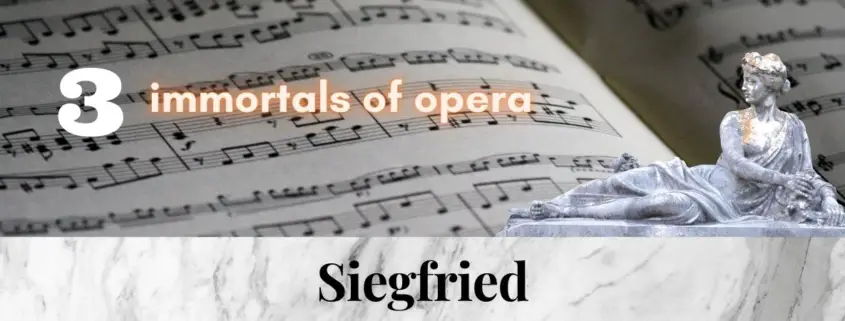3 immortal pieces from the opera SIEGFRIED by Wagner- with the best interpretations from YouTube (Hits, Best of)
The Ring of the Nibelung is a total work of art on a par with works of world literature such as Homer’s Iliad or Dante’s Divina commedia. It is astonishing how homogeneous this work appears to us, which was created over a period of 25 years and in a complex process of development. “Siegfried” is a huge heroic epic about a revolutionary. It ends with one of the great love apotheoses of the opera genre.
Siegfried forges the sword
In this piece we hear the motif of the sword Nothung, which Siegmund already used in “Die Walküre”. With this motif, he fires up the bellows. Again and again, the motif sounds heavily in the winds.
Listen to Lauritz Melchior’s interpretation in this scene. He sings this act, so demanding for the tenor, with great intensity and vocal power. He was probably the most brilliant Siegfried in the history of recording.
Nothung! Nothung! Neidliches Schwert – Melchior
Brünnhilde, the highly dramatic soprano role
Brünnhilde wakes up and welcomes the day. She sees her awakener and recognizes in him Siegfried, whom she once protected and always loved.
This scene is one of the greatest scenes in the entire Ring! Brünnhilde’s awakening motif sounds. This beautiful motif of the awakening Brünnhilde shows how Wagner knew how to form great things from 2 simple chords. He lets the E minor chord swell and decay in the winds and picks up the note again only in the winds in a crescendo and lets it play around with the harps. The harp arpeggios unmistakably recall the awakening of nature at the beginning of the Ring in the prelude to Rheingold.
Musical quote: Brunhilds Awakening motif
Brünnhilde is the role for a highly dramatic soprano. After the war this role was dominated by 3 female singers for 25 years: Astrid Varnay, Martha Mödl and Birgit Nilsson. Brünnhilde appears in 3 of the 4 evenings of the ring. The role in Siegfried is the one with the highest tessitura and therefore very demanding. In addition, she has to sing against a huge orchestra, which likes to play loud to increase the effect.
Birgit Nilsson was a vocal wonder. “Vocal chords of steel”, “trumpet” were attributes that were often heard when she outshone other singers and the orchestra with her voice. During the recordings for the ring, it is said that the loudspeaker often sounded “Please step back three steps, Mrs. Nilsson, when high notes are played”, because the sound waves overtaxed the microphones.
Heil dir, Sonne! Heil dir, Licht! – Nilsson
Ewig war ich, ewig bin ich ! – I always was, I always am
>Brünnhilde is also pleased to see her horse Grane. When Siegfried besets her, she realises with horror that without armour, sword and helmet she is no longer divine and thus defenceless. Never before has a man dared to approach her. Now she is a mortal woman and asks Siegfried to keep her virginity. In the arms of Siegfried she is overwhelmed by the human passion of love. Siegfried urges her to unite and misses the last opportunity to become knowing.
Brünnhilde asks Siegfried to keep her divine virginity. Dazu hat er ein wunderschönes Motiv komponiert. Dieses “Ewige-Liebe” Motiv hat Richard Wagner auch im Siegfried-Idyll verwendet (siehe weiter unten).
Musical quote: Eternal love motif
But Siegfried’s heating does not allow this to happen, and Brünnhilde is carried away. The opera ends with resounding horns and an ecstatic love duet in C major: “Leuchtende Liebe! Lachender Tod!” Shortly before the end there is another pause and the work ends with a C major chord.
We this excert from the Böhm recording. It is from the sixties and documents the production of Wieland Wagner.
Ewig war ich, ewig bin ich – Nilsson / Windgassen







Leave a Reply
Want to join the discussion?Feel free to contribute!